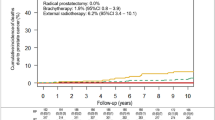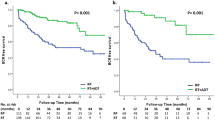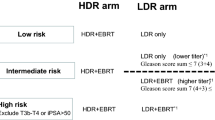Abstract
To examine the difference in Prostate Specific Antigen (PSA)-Relapse Free Survival (RFS) in patients (pts) with prostate cancer treated with permanent prostate brachytherapy (PPB) alone (monotherapy) or combined modality PPB and external radiotherapy (CMT) by a matched pair analysis. There were 1476 pts who were treated loosely based on the American Brachytherapy Society criteria for monotherapy or CMT. PSA-RFS was based upon the Kattan modification of the ASTRO consensus panel definition. A computer generated matching process was undertaken to produce two equally weighted pairs of patients divided by treatment methodology and Kaplan-Meier PSA-RFS curves were generated and compared by χ2 testing. All pts were treated between 1992 and 2000 with a 6-y PSA-RFS of 81.9%. The median follow-up was 34.7 months. Patients treated with CMT presented with higher pre-treatment PSA values, Gleason sum score, clinical stage, risk classification, and were more likely to be treated with neoadjuvant hormones. A matched-pair analysis with 314 pts in each group was created stratified by the addition of neoadjuvant hormones, Gleason score sum and the pretreatment PSA value. Actuarial 5-y PSA-RFS was 77.0% for the monotherapy group and 81.1% for the combined therapy group (P=0.54).
χ2 testing by pretreatment PSA value, Gleason score sum, risk stratification, isotope and the addition of neoadjuvant hormones failed to identify any group with a significant difference in 5-y PSA-RFS. In conclusion, this retrospective study presents a large cohort of patients treated with PPB that failed to identify a significant advantage for the addition of combined therapy. A matched pair analysis performed also failed to identify any significant difference based on treatment modality.
This is a preview of subscription content, access via your institution
Access options
Subscribe to this journal
Receive 4 print issues and online access
$259.00 per year
only $64.75 per issue
Buy this article
- Purchase on Springer Link
- Instant access to full article PDF
Prices may be subject to local taxes which are calculated during checkout





Similar content being viewed by others
References
Potters L. . Permanent prostate brachytherapy: lessons learned, lessons to learn. Oncology (Huntingt) 2000 14: 981–991.
Grado GL et al. Actuarial disease-free survival after prostate cancer brachytherapy using interactive techniques with biplane ultrasound and fluoroscopic guidance. Int J Radiat Oncol Biol Phys 1998 42: 289–298.
Dattoli M et al. 103Pd brachytherapy and external beam irradiation for clinically localized, high-risk prostatic carcinoma. Int J Radiat Oncol Biol Phys 1996 35: 875–879.
Beyer DC, Priestley JB Jr. . Biochemical disease-free survival following 125I prostate implantation. Int J Radiat Oncol Biol Phys 1997 37: 559–563.
Stokes SH et al. Transperineal ultrasound-guided radioactive seed implantation for organ-confined carcinoma of the prstate. Int J Radiat Oncol Biol Phys 1997 37: 337–341.
Ragde H et al. Ten-year disease free survival after transperineal sonography-guided iodine-125 brachytherapy with or without 45-gray external beam irradiation in the treatment of patients with clinically localized, low to high Gleason grade prostate carcinoma. Cancer 1998 83: 989–1001.
Stock RG et al. Prostate specific antigen findings and biopsy results following interactive ultrasound guided transperineal brachytherapy for early stage prostate carcinoma. Cancer 1996 77: 2386–2392.
Nag S et al. American Brachytherapy Society (ABS) recommendations for transperineal permanent brachytherapy of prostate cancer. Int J Radiat Oncol Biol Phys 1999 44: 789–799.
Critz FA et al. Simultaneous irradiation for prostate cancer: intermediate results with modern techniques. J Urol 2000 164: 738–741.
Potters L et al. The role of external beam irradiation in patients undergoing prostate brachytherapy. Uro Oncology 2000 5: 112–117.
Fleming ID et al. AJCC Cancer Staging Manual, Philadelphia, Pensylvania, Fifth Edition. Lippincitt-Raven 1997
Beyer D et al. American Brachytherapy Society recommendations for clinical implementation of NIST-1999 standards for (103)palladium brachytherapy. Int J Radiat Oncol Biol Phys 2000 47: 273–275.
Nath R et al. Correlation of medical dosimetry quality indicators to the local tumor control in patients with prostate cancer treated with iodine-125 interstitial implants. Med Phys 1998 25: 2293–2307.
Stone NN, Stock RG. . Brachytherapy for prostate cancer: real-time three-dimensional interactive seed implantation. Tech Urol 1995 1: 72–80.
Consensus statement: guidelines for PSA following radiation therapy. American Society for Therapeutic Radiology and Oncology Consensus Panel. Int J Radiat Oncol Biol Phys 1997 37: 1035–1041.
Kattan MW, Fearn PA, Leibel S, Potters L. . The definition of biochemical failure in patients treated with definitive radiotherapy. Int J Radiat Oncol Biol Phys 2000 48: 1469–1474.
Cox DR, Abadir R. . Regression models and life tables. J Roy Statist Soc 1972 34: 187–220.
Kaplan EL, Meier P. . Nonparametric estimation from incomplete observations. J Cancer Res Clin Oncol 1958 53: 457–816.
Partin AW et al. Combination of prostate-specific antigen, clinical stage, and Gleason score to predict pathological stage of localized prostate cancer. A multi-institutional update. JAMA 1997 277: 1445–1451.
Davis BJ et al. The radial distatnce of extraprostatic extension of prostate adenocarcimoma: Implications for prostate brachytherapy. Int J Radiat Oncol Biol Phys 1998 42: 132–132.
Ragde H et al. Modern prostate brachytherapy. Prostate specific antigen results in 219 patients with up to 12 y of observed follow-up. Cancer 2000 89: 135–141.
Blasko JC, Grimm PD, Sylsvester JE, Cavanagh W. . The role of external beam radiotherapy with I-125/Pd-103 brachytherapy for prostate carcinoma. Radiother Oncol 2000 57: 273–278.
Zelefsky MJ et al. Postimplantation dosimetric analysis of permanent transperineal prostate implantation: improved dose distributions with an intraoperative computer-optimized conformal planning technique. Int J Radiat Oncol Biol Phys 2000 48: 601–608.
Vicini FA, Kestin LL, Martinez AA. . The importance of adequate follow-up in defining treatment success after external beam irradiation for prostate cancer. Int J Radiat Oncol Biol Phys 1999 45: 553–561.
Gelblum DY, Potters L. . Rectal complications associated with transperineal interstitial brachytherapy for prostate cancer. Int J Radiat Oncol Biol Phys 2000 48: 119–124.
Gelblum D et al. Urinary morbidity following ultrasound-guided transperineal prostate seed implantation. Int J Radiat Oncol Biol Phys 1999 45: 59–67.
Zeitlin SI et al. High dose combination radiotherapy for the treatment of localized prostate cancer. J Urol 1998 160: 91–95.
Brandeis JM, Litwin MS, Burnison CM, Reiter RE. . Quality of life outcomes after brachytherapy for early stage prostate cancer. J Urol 2000 163: 851–857.
Gallagher PE, Klemp T, Smith SL . Medicare RBRVS: The Physician's Guide Fifth edn. American Medical Association: Chicago 2001
Dattoli M et al. Prognostic role of serum prostatic acid phosphatase for 103Pd-based radiation for prostatic carcinoma [In Process Citation]. Int J Radiat Oncol Biol Phys 1999 45: 853–856.
Zelefsky MJ et al. Five-year biochemical outcome and toxicity with transperineal CT-planned permanent I-125 prostate implantation for patients with localized prostate cancer. Int J Radiat Oncol Biol Phys 2000 47: 1261–1266.
Lederman GS et al. Retrospective stratification of a consecutive cohort of prostate cancer patients treated with a combined regimen of external-beam radiotherapy and brachytherapy. Int J Radiat Oncol Biol Phys 2001 49: 1297–1303.
Author information
Authors and Affiliations
Corresponding author
Rights and permissions
About this article
Cite this article
Potters, L., Fearn, P. & Kattan, M. The role of external radiotherapy in patients treated with permanent prostate brachytherapy. Prostate Cancer Prostatic Dis 5, 47–53 (2002). https://doi.org/10.1038/sj.pcan.4500552
Received:
Revised:
Accepted:
Published:
Issue Date:
DOI: https://doi.org/10.1038/sj.pcan.4500552



